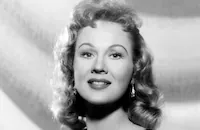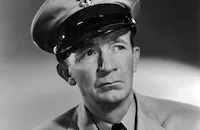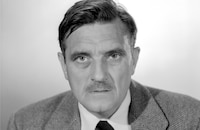Along the Great Divide

Brief Synopsis
Cast & Crew
Raoul Walsh
Kirk Douglas
Virginia Mayo
John Agar
Walter Brennan
Ray Teal
Film Details
Technical Specs

Synopsis
U.S. Marshal Len Merrick and his deputies Billy Shear and Lou Gray stop the lynching of rustler Pop Keith, whom rancher Ed Roden believes is the killer of his son Ed, Jr. Despite the vehement protests of Roden and his younger son Dan, Merrick insists on bringing Keith to trial in the distant town of Santa Loma. Professing his innocence, Keith begs Merrick to let him escape. As it is almost dark, Keith then persuades Merrick and his deputies to spend the night at his nearby farm. When Merrick spots Roden removing his son's body from the scene of the murder, he sends the others on to the Keith farm and joins Roden, who reiterates his belief that Keith is the killer. After Roden leaves the area, Merrick finds a watch, which he takes with him. Near the Keith farm, he hears gunshots, and approaches cautiously. He discovers that Keith's daughter Ann is attempting to free her father and disarms her. Later, she makes a second unsuccessful try to help Keith escape. Outside the house, Merrick encounters some cattlemen, who warn the marshal that Roden will kill all of them. Merrick, his deputies, Keith and Ann then leave immediately for Santa Loma along the shorter desert route. When Keith sings the song, "Down in the Valley," Merrick angrily orders him to stop, but after Billy reveals that Merrick's father used to sing the song, Keith realizes he has found a weak spot and continues singing. Later, during a rest stop, Keith taunts Merrick, asking if he reminds the marshal of his own father, which causes Merrick to attack the older man. Soon Merrick spots Roden and his men, and the group takes shelter behind some rocks. During the ensuing gunfight, their main source of water is destroyed, and Billy is wounded. Merrick then captures Dan and takes him along as a safeguard against future attacks. Even though Billy is badly wounded, and they have only the water in their canteens, they continue across the desert. When Billy dies, Ann denounces Merrick for his unyielding devotion to the law. To justify himself, Merrick divulges the one time he forgot the law: Once, acting as his father's deputy, he left his father alone to deliver two prisoners for trial because he thought they deserved to be lynched. Unable to stop a lynching party, his father was hanged along with the prisoners. On the arduous journey, the group endures lack of water and a sandstorm. Finally they reach a water hole, only to discover that the water has gone bad. A heat-crazed Dan insists that his father poisoned it in order to kill him. Keith points out that a river lies only a half-day's ride to the south, but aware that the river marks the Mexican border, Merrick refuses to turn in that direction. The others rebel, and as insurance, Merrick forces Ann to share his horse. Finally, exhausted, Merrick's horse stumbles, and Keith grabs his gun. Dan encourages Keith to kill the marshal, but instead, when Gray grabs a rifle, intending to take control and head for water, Keith shoots and kills the deputy. The remaining members of the group continue on foot to Santa Loma, where Merrick turns Keith and Dan over to the sheriff. Keith's trial is held that night. Merrick, who has begun to doubt the fairness of the law, speaks in Keith's favor, but despite his efforts, Keith is found guilty and sentenced to hang. The next morning, a distraught Ann accuses Merrick of failing to make sure he had arrested the right man. Disgusted, Merrick pulls off his badge, and the watch falls from his pocket. Seeing the inscription "To Dan" inside, he realizes that Dan killed his brother and confronts the Rodens. After accusing Roden of giving Ed everything while giving him nothing, Dan shoots at his father and runs off. Merrick then kills Dan, and a grateful Ann embraces him, causing Keith to express his dismay at the prospect of a lawman in the family.

Director

Raoul Walsh
Cast

Kirk Douglas

Virginia Mayo

John Agar

Walter Brennan

Ray Teal
Hugh Sanders

Morris Ankrum
James Anderson
Charles Meredith
Lane Chandler

Kenneth Macdonald
Steve Clark
Carl Harbaugh
Zon Murray
Sam Ash
Steve Darrell
Al Ferguson
Guy Wilkerson
Crew
Gordon Bau
G. W. Berntsen
Marjorie Best
David Buttolph
Edward Carrere
Walter Doniger
Walter Doniger
Oren Haglund
Leslie G. Hewitt
Sid Hickox
Lewis Meltzer
Maurice De Packh
Thomas Reilly
Anthony Veiller

Videos
Movie Clip


Film Details
Technical Specs

Articles
Along the Great Divide
A rejoinder of sorts to William Wellman's The Ox-Bow Incident (1943), which ends with the lynching of three innocent men, Along the Great Divide pits Douglas' US marshal against a necktie party of concerned citizens as he attempts to bring accused murderer Walter Brennan to a fair trial across the burning Wyoming prairie. Though the actor was unimpressed with the script's Oedipal inclinations (something of a trademark for Walsh, whose protagonists during this time were often plagued by mother or father issues) he did enjoy learning the craft of cowboying, from using a six-gun to handling a horse. Raoul Walsh had come to the project on the heels of shooting the expansive Captain Horatio Hornblower (1951) abroad. Having finished Bretaigne Windust's studio-bound The Enforcer (1951) for Warners (for which he declined credit), Walsh was more than ready to be out in the elements, specifically the Mojave Desert, where he had staged the climax of High Sierra (1941) some years earlier.
Walter Doniger had called his original story "Along the Great Divide" but the film went into production on October 16, 1950 as The Travelers. Adapting the tale with Lewis Meltzer, Doniger kept the Warners research department busy with a battery of questions related to Wyoming history, water rights, frontier jurisprudence and issues of physical accuracy: how long could a horse and rider survive without water in the high desert and could a single horseman outrun a stagecoach? Wrapped on November 25, 1950 and shunted into movie theaters on June 6, 1951, the film garnered mixed reviews. In The New York Times, Bosley Crowther found Douglas' performance "just a little shy of absurd" while allowing that "like initiation into a fraternity, it seems that every young male star must do at least one performance in a western." Deserving of reevaluation today on the strength of its own dramatic and technical merits (particularly the cinematography of Sid Hickox), Along the Great Divide points intriguingly to other transporting-the-prisoner films, a pan-genre subcategory that includes Richard Fleischer's The Narrow Margin (1952), Anthony Mann's The Naked Spur (1953), , Delmer Daves' 3:10 to Yuma (1957), Clint Eastwood's The Gauntlet (1977), Stephen Frears' The Hit (1984) and David Twohy's Pitch Black (2000).
Producer: Anthony Veiller
Director: Raoul Walsh
Screenplay: Walter Doniger, Lewis Meltzer (screenplay); Walter Doniger (story)
Cinematography: Sid Hickox
Art Direction: Edward Carrere
Music: David Buttolph
Film Editing: Thomas Reilly
Cast: Kirk Douglas (Marshal Len Merrick), Virginia Mayo (Ann Keith), John Agar (Billy Shear), Walter Brennan (Timothy 'Pop' Keith), Ray Teal (Deputy Lou Gray), Hugh Sanders (Frank Newcombe), Morris Ankrum (Ed Roden), James Anderson (Dan Roden), Charles Meredith (Judge Marlowe).
BW-88m. Closed Captioning.
by Richard Harland Smith
Sources:
The Ragman's Son: An Autobiography by Kirk Douglas (Simon &U Schuster, 1988)
The Films of Kirk Douglas by Tony Thomas (Citadel Press, 1991)
Raoul Walsh: The True Adventures of Hollywood's Legendary Director by Marilyn Ann Moss (The University Press of Kentucky, 2011)

Along the Great Divide
Virginia Mayo (1920-2005)
She was born Virginia Clara Jones in St. Louis, Missouri on November 30, 1920, and got her show business start at the age of six by enrolling in her aunt's School of Dramatic Expression. While still in her teens, she joined the nightclub circuit, and after paying her dues for a few years traveling across the country, she eventually caught the eye of movie mogul Samuel Goldwyn. He gave her a small role in her first film, starring future husband, Michael O'Shea, in Jack London (1943). She then received minor billing as a "Goldwyn Girl," in the Danny Kaye farce, Up In Arms (1944). Almost immediately, Goldwyn saw her natural movement, comfort and ease in front of the camera, and in just her fourth film, she landed a plumb lead opposite Bob Hope in The Princess and the Pirate (1944). She proved a hit with moviegoers, and her next two films would be with her most frequent leading man, Danny Kaye: Wonder Man (1945), and The Kid from Brooklyn (1946). Both films were big hits, and the chemistry between Mayo and Kaye - the classy, reserved blonde beauty clashing with the hyperactive clown - was surprisingly successful.
Mayo did make a brief break from light comedy, and gave a good performance as Dana Andrews' unfaithful wife, Marie, in the popular post-war drama, The Best Years of Their Lives (1946); but despite the good reviews, she was back with Kaye in The Secret Life of Walter Mitty (1947), and A Song Is Born (1948).
It wasn't until the following year that Mayo got the chance to sink her teeth into a meaty role. That film, White Heat (1949), and her role, as Cody Jarrett's (James Cagney) sluttish, conniving wife, Verna, is memorable for the sheer ruthlessness of her performance. Remember, it was Verna who shot Cody¿s mother in the back, and yet when Cody confronts her after he escapes from prison to exact revenge for her death, Verna effectively places the blame on Big Ed (Steve Cochran):
Verna: I can't tell you Cody!
Cody: Tell me!
Verna: Ed...he shot her in the back!!!
Critics and fans purred over the newfound versatility, yet strangely, she never found a part as juicy as Verna again. Her next film, with Cagney, The West Point Story (1950), was a pleasant enough musical; but her role as Lady Wellesley in Captain Horatio Hornblower R.N. (1951), co-starring Gregory Peck, was merely decorative; that of a burlesque queen attempting to earn a university degree in the gormless comedy, She¿s Working Her Way Through College (1952); and worst of all, the Biblical bomb, The Silver Chalice (1954) which was, incidentally, Paul Newman's film debut, and is a film he still derides as the worst of his career.
Realizing that her future in movies was slowing down, she turned to the supper club circuit in the 60s with her husband, Michael O'Shea, touring the country in such productions as No, No Nanette, Barefoot in the Park, Hello Dolly, and Butterflies Are Free. Like most performers who had outdistanced their glory days with the film industry, Mayo turned to television for the next two decades, appearing in such shows as Night Gallery, Police Story, Murder She Wrote, and Remington Steele. She even earned a recurring role in the short-lived NBC soap opera, Santa Barbara (1984-85), playing an aging hoofer named "Peaches DeLight." Mayo was married to O'Shea from 1947 until his death in 1973. She is survived by their daughter, Mary Johnston; and three grandsons.
by Michael T. Toole
Virginia Mayo (1920-2005)
TCM Remembers - John Agar
Popular b-movie actor John Agar died April 7th at the age of 81. Agar is probably best known as the actor that married Shirley Temple in 1945 but he also appeared alongside John Wayne in several films. Agar soon became a fixture in such films as Tarantula (1955) and The Mole People (1956) and was a cult favorite ever since, something he took in good spirits and seemed to enjoy. In 1972, for instance, the fan magazine Famous Monsters of Filmland mistakenly ran his obituary, a piece that Agar would later happily autograph.
Agar was born January 31, 1921 in Chicago. He had been a sergeant in the Army Air Corps working as a physical trainer when he was hired in 1945 to escort 16-year-old Shirley Temple to a Hollywood party. Agar apparently knew Temple earlier since his sister was a classmate of Temple's. Despite the objections of Temple's mother the two became a couple and were married shortly after. Temple's producer David Selznick asked Agar if he wanted to act but he reportedly replied that one actor in the family was enough. Nevertheless, Selznick paid for acting lessons and signed Agar to a contract.
Agar's first film was the John Ford-directed Fort Apache (1948) also starring Temple. Agar and Temple also both appeared in Adventure in Baltimore (1949) and had a daughter in 1948 but were divorced the following year. Agar married again in 1951 which lasted until his wife's death in 2000. Agar worked in a string of Westerns and war films such as Sands of Iwo Jima (1949), Breakthrough (1950) and She Wore a Yellow Ribbon (1949). Later when pressed for money he began making the films that would establish his reputation beyond the gossip columns: Revenge of the Creature (1955), The Brain from Planet Arous (1957), Invisible Invaders (1959) and the mind-boggling Zontar, the Thing from Venus (1966). The roles became progressively smaller so Agar sold insurance and real estate on the side. When he appeared in the 1988 film Miracle Mile his dialogue supposedly included obscenities which Agar had always refused to use. He showed the director a way to do the scene without that language and that's how it was filmed.
By Lang Thompson
DUDLEY MOORE, 1935-2002
Award-winning actor, comedian and musician Dudley Moore died on March 27th at the age of 66. Moore first gained notice in his native England for ground-breaking stage and TV comedy before later building a Hollywood career. Like many of his peers, he had an amiable, open appeal that was balanced against a sharply satiric edge. Moore could play the confused innocent as well as the crafty schemer and tended to command attention wherever he appeared. Among his four marriages were two actresses: Tuesday Weld and Suzy Kendall.
Moore was born April 19, 1935 in London. As a child, he had a club foot later corrected by years of surgery that often left him recuperating in the hospital alongside critically wounded soldiers. Moore attended Oxford where he earned a degree in musical composition and met future collaborators Peter Cook, Jonathan Miller and Alan Bennett. The four formed the landmark comedy ensemble Beyond the Fringe. Though often merely labelled as a precursor to Monty Python's Flying Circus, Beyond the Fringe was instrumental in the marriage of the piercing, highly educated sense of humor cultivated by Oxbridge graduates to the modern mass media. In this case it was the revue stage and television where Beyond the Fringe first assaulted the astonished minds of Britons. Moore supplied the music and such songs as "The Sadder and Wiser Beaver," "Man Bites God" and "One Leg Too Few." (You can pick up a CD set with much of the stage show. Unfortunately for future historians the BBC commonly erased tapes at this period - why? - so many of the TV episodes are apparently gone forever.)
Moore's first feature film was the 1966 farce The Wrong Box (a Robert Louis Stevenson adaptation) but it was his collaboration with Peter Cook on Bedazzled (1967) that's endured. Unlike its tepid 2000 remake, the original Bedazzled is a wolverine-tough satire of mid-60s culture that hasn't aged a bit: viewers are still as likely to be appalled and entertained at the same time. Moore not only co-wrote the story with Cook but composed the score. Moore appeared in a few more films until starring in 10 (1979). Written and directed by Blake Edwards, this amiable comedy featured Moore (a last-minute replacement for George Segal) caught in a middle-aged crisis and proved popular with both audiences and critics. Moore's career took another turn when his role as a wealthy alcoholic who falls for the proverbial shop girl in Arthur (1981) snagged him an Oscar nomination as Best Actor and a Golden Globe win.
However Moore was never able to build on these successes. He starred in a passable remake of Preston Sturges' Unfaithfully Yours (1984), did another Blake Edwards romantic comedy of moderate interest called Micki + Maude (1984, also a Golden Globe winner for Moore), a misfired sequel to Arthur in 1988 and a few other little-seen films. The highlight of this period must certainly be the 1991 series Orchestra where Moore spars with the wonderfully crusty conductor Georg Solti and leads an orchestra of students in what's certainly some of the most delightful television ever made.
By Lang Thompson
TCM Remembers - John Agar
Quotes
Trivia
Notes
The film's working title was The Travelers. It was shot on location in the Alabama Hills region of Lone Pine, CA and in the Mojave Desert. This film was the first western in which Kirk Douglas appeared. As critic Bosley Crowther noted in his review of the film in the New York Times, "Like initiation into a fraternity, it seems that every young male star must do at least one performance in a western."

Miscellaneous Notes
Released in United States Winter January 1, 1951
Released in United States Winter January 1, 1951













